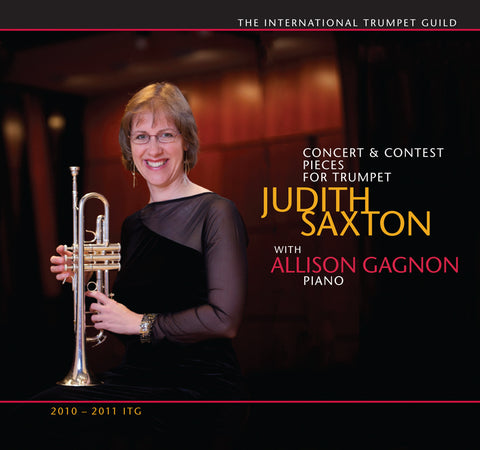Concert & Contest Pieces for Trumpet and Piano
Background:
FOR OVER TEN YEARS, I have had the idea of recording a compact disk of trumpet music that featured common pieces that students, teachers and concert performers would use either for contests or concerts. The works I have chosen, except perhaps the Koetsier Concertino, are among those often used in most American teaching studios and in recitals. Yet when I began seriously contemplating this project in 2008, my research then indicated that most had not been recorded at all, or not in the last 40 years (hence, not on CD). I believe that since then a few have been recorded, but have had limited distribution. It is my hope that if I have introduced some of these pieces to you for the first time, you will enjoy them as I have and seek them out for further exploration. In my travels around the world, I am repeatedly surprised at how keen and excited trumpeters are to learn of new pieces. Here, on this one disk, we feature three French, one Italian, one Dutch and two American composers – a fantastic smorgasbord of tunes from the around the globe.
Many of these works warrant frequent mention on Music Educator National Conference (MENC) festival and contest lists, and in light of the proliferation of dubious and un-juried resources available today, it is more crucial than ever that there are standard recordings available on which a student can rely. In fact, among the first questions a student asks when beginning work on a new piece remains “Is there a recording available?” Regardless of the trumpeter’s level, when hearing a piece for the first time, it is vital that their first exposure to the piece be one that models appropriate and engaging tone quality, a clear sense of musical line and appropriately defined style. Wearing my music educator hat, I recognize that it is critical for a healthy approach to these pieces that they have a reliable reference, and I am very pleased and extremely humbled and honored that the International Trumpet Guild has chosen my project for distribution to ITG members world-wide.
The Concertino by Jan Koetsier stands alone on this disk as the one piece that has not been mentioned in relation to festival lists, but in the course of choosing the repertoire I discovered that no one, to the best of my knowledge, had recorded (at least for public release) this wonderful piece. It is an incredible work from a composer who has graced the brass world with many intriguing and unique compositions, all of them remaining so fresh and yet still idiomatic. I am happy to present this gem to you here, as one I hope will be included in many concerts to come.
Repertoire:
Joseph (Jacques) Edouard Barat (1882-1963) studied music in Paris and was a bandmaster with the French army. Fantaisie en B Bemol was introduced to me early in my teaching career while working with talented students in the northern suburbs of Chicago. It is absolutely charming, a delightful recital piece with a good amount of technical display, yet the range is not demanding. I noticed that my copy was purchased from the Lou Gehrig’s disease annual fundraiser (ALS–Mammoth Music Mart) in Skokie, IL, my Chicago home of 10 years.
Ennio Porrino (1910-1959). Concertino, like the Koetsier and Giannini, was originally written for trumpet and orchestra and transcribed by the composer for trumpet and piano. Mr. Porrino wrote this for Reginaldo Caffarelli of transposition and etude book fame. Porrino only lived 49 years and was born and died in Italy. He was a conductor and a composer and taught at the Conservatories of both Rome and Naples. He attended a course under Respighi and one can hear his teacher’s influence in this work with its bursts of color and exuberant, nationalistic character. CConcertino is a theme in four parts with two variations. The first variation, a beautifully spun slow melody highlights Porrino’s penchant for Gregorian and Sardinian chant. The second is a double-tonguing variation marked ‘very rhythmic and brilliant’, and leads with a splash into the finale which allows a chance for the player to instill his/her own personality within the cadenza (marked ‘with humor’). He then ends the piece with an embellished, technical display. I utilize the C trumpet for this recording, and first became aware of the Concertino during my undergraduate years on the Bb trumpet.
Jan Koetsier (1911-2006). Although Dutch, Jan Koetsier grew up in Berlin, where he also studied music (piano, composition, conducting). He had a distinguished career as a conductor of the Amsterdam Concertgebouw and chief conductor of the Bavarian RadioSymphony Orchestra. A notable composer in the brass world, he’s written a number of memorable brass chamber pieces and began the Foundation for Brass Chamber Music in 1993 at the Hochschule für Musik und Theater München where he concluded his career. I bought this Concertino at an ITG conference on a recommendation from Carole Dawn Reinhart, to whom it is dedicated, and have since enjoyed the Richard Strauss–tinged harmonies of the first movement and the unexpected moods he evokes in each of the other two movements. The second movement is especially ingeniously crafted: every 3 bars in the piano equal one bar in the trumpet. Because the end of the entire piece is a real tour de force, an optional shorter, version is included in the score. The publication has solo parts in both B-flat and C. I chose to record the work on the C trumpet, inspired by the brilliance and intensity of the sounds Koetsier composed.
Vittorio Giannini (1903-1966) studied violin at Conservatory in Italy from the age of nine and returned to eventually become professor of composition at first Julliard, Manhattan School of Music, then Curtis. He was the founder and president of the University of North Carolina School of the Arts, (UNCSA) where I teach and where we recorded this disk. He is known as a neoromantic composer and this concerto is no exception. Concerto for Trumpet is another work where the composer did his own piano reduction from the orchestral score. This piece is found on the most contest lists of any on this disk and when performed in its entirety commands respect from the player, especially in terms of the agility and strength required to meet the musical demands. There is little chance for rest in any of the movements, yet each movement is easily strong enough to be programmed alone. The first movement heralds the trumpet in with a commanding 4-note motive that appears throughout in many guises. An introspective theme then appears twice to give the listener a chance to recoup before the brilliant ending. I have performed the second movement both with a straight (trumcor) and cup mute and chose the latter for this recording as a good color contrast from the bombast and bravura style in the outer two movements. The third movement opens with a cheeky theme that relinquishes itself to a strange, winsome chromatically intervallic section, then returns to spin out the finale which eventually hearkens back to the heralding 4-note motive of the first movement, efficiently tying together this war horse of a piece.
Paul Louis Rougnon (1846-1934). Another early 20 century French composer, he was a professor of solfege at Paris conservatory, a pianist and a composer who wrote a number of compositions for sax and viola as well wonderful showpiece for the trumpet. Premier Solo de Concert works equally well on Bb or C trumpet. I perform it here on Bb trumpet as I have my students do. The piece encompasses a wide range of expression and character, while maintaining a very “friendly” range. Jouko Harjanne has the only other recording of which I am aware.
Jean Clergue (1905-1971) was a French composer and was well known as a conductor and worked as the head of the Radio Toulouse-Pyrenees Orchestra in the 1940s. His compositional style was typically French, following in the footsteps of Debussy and Faure. This is especially noticeable in the opening Sarabande, a slow stately dance in triple meter that was popular in France. The Rigaudon is another Baroque dance form whose hopping steps define its couples folk dance origins in the 17th century France. There is a beautiful cup muted section that acts as transitional material and returns the piece to the Rigaudon for the finish. I first learned this piece as an undergraduate and it remains one of my favorites today.
Maurice C. Whitney (1909-1984) wrote his Concertino originally for concert band and then wrote the piano reduction himself. He was an active music educator, conductor, organist and arranger for theater and dance companies in New York State. He wrote accessible music for a variety of genres from choral to chamber music and band to solo instrumental works as well as a few music theory and band texts. This piece is from the middle 1950’s and reflects throughout the whimsical spirit of this uncomplicated time. The first movement is straight-ahead and no-nonsense, the second a gorgeous, Gershwin-esque melody that bluesily leans its way from the piano to the trumpet and back. It’s marked muted at the beginning and I change mutes with each new entrance: cup, straight and harmon to evoke more of a sultry, jazzy atmosphere. The last movement is a spirited rondo, very much like a child’s play time with imaginary trips to various islands, yet always returning to the rounded sprite of a home theme with which it began.
Copyright:
Judith Saxton
University of North Carolina School of the Arts
Winston Salem, North Carolina
November 2010
Instruments and Other Information:
The compositions by Barat, Giannini, Rougnon, Clerque, and Whitney are played on B-flat trumpet while the works by Porrino and the Koetsier are played on a C trumpet.
The following equipment was used in recording this disk:
Bach 37 ML Bb trumpet
Bach 229 – A pipe C trumpet
Bach 3C mouthpiece, 26 throat
Piano: Hamburg Steinway
As a Conn-Selmer Artist, Ms. Saxton performs here on Bach trumpets exclusively.
Recorded August 30 – Sept. 3, 2010 in Watson Chamber Music Hall, University of North Carolina School of the Arts.
Producer: Judith A. Saxton
Recording Engineer; mixing and mastering: Evan Richey
Additional music editing: Alison Gagnon
Piano Technician: Bill Huesman
ITG CD Coordinator/Project Manager: James Olcott
Graphic design: Jan Conradi
Cover photograph: G. Allen Aycock

